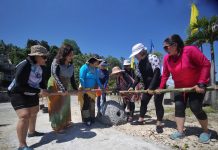
by Kenneth Irving Ong
As lifestyles evolve, professions evolve along with the demand for new services and specialization and it is with a demand for individuals in the culinary arts that Davao’s culinary schools were born. Currently, there are three culinary schools in Davao City, each offering short term lifestyle and introductory classes to professional culinary classes.
The schools
Located at the Holiday Gym compound along F. Torres Street is the Center for Asian Culinary Studies (CACS). It was founded in 2007 by renowned chef and food columnist Gene Gonzales along with some friends he has here in Davao. The CACS offers short-term introductory lifestyle courses in culinary and pastry making aside from basic and professional commercial cooking courses that are recognized by the Technical Education and Skills Development Authority (TESDA).
Another school recognized by TESDA is the Metropolitan Occupational Science and Technology (MOST) Institute located along Ramon Magsaysay Avenue. MOST Institute Davao is one of five MOST campuses located around the country. They also offer seasonal lifestyle courses and aside from their Bases de Artes Culinares (Certificate in Culinary Arts) course that includes a Halal culinary arts course.
The Institute of International Culinary and Hospitality Entrepreneurship (I-Chef) on the other-hand is recognized by the Commission on Higher Education and is the Mindanao campus of Technical and Further Education (TAFE) New South Wales. The school is located at a new purpose-built five-storey building along De Jesus Street.
Fees
Getting started in the culinary field is not cheap. Enrollment fees for a basic accredited certificate course starts at Php44,500 at MOST to Php63,000 at CACS, iChef offers fundamental commercial cookery at Php53,850, this includes the ingredients, jackets, knives and books to be used by the students of CACS and I-Chef. MOST Institute’s enrollment fee does not include ingredients, “We believe that to become an effective chef, the students should experience going to the market themselves to learn how to look for ingredients, and get to be familiar with the actual prices of these ingredients.” notes MOST Institute’s Jacqueline Relacion, student affairs officer.
Aside from basic certificate courses, CACS and I-Chef both offer diplomas for professional culinary classes that are more intense with more hours with more mandatory on-the-job training. “Here at iChef, we give students the option to take either the TAFE diploma course or the iChef diploma course,” says I-Chef officer in-charge Arlene Ozoa,” of course the TAFE program is a little more expensive since we register them also with the school in Australia. But this allows the students to be treated as though they were schooled in Australia and would really help if ever they plan to migrate to Australia as a TAFE certificate would add 60 immigration points.” TAFE NSW is Australia’s largest training provider, and it is among the largest in the world.
Graduates from CACS get a TESDA certificate after pass the regulatory body’s assessment. Agnes Acena, CACS marketing officer, says “The TESDA is the government agency that regulates and evaluates that all technical professionals are up to global standards and a TESDA certificate is recognized worldwide and can be used to find employment wherever in the world. Our curriculum here at CACS uses a ladderized curriculum, meaning you can take the course in phases.”
These professional courses can cost from Php297,000 for a one-year course at CACS to Php288,000 for iChef’s master diploma and Php330,600 for iChef’s TAFE accredited program. I-Chef also offers Bachelor of Science in International Culinary and Hospitality Entrepreneurship which is a four-year course that combines culinary and hospitality together for Php55,600 a semester. The MOST Institute does not yet have a professional diploma program but is planning to roll out a professional course by 2011.
Rewards after graduation
“A lot of our graduates use their culinary studies as a stepping stone to go abroad since there is a huge demand for chefs overseas either in cruise ships or land-based (hotels).” notes Ozoa. Chefs usually start as understudies and work their way up the kitchen ladder.
Some individuals who are already in the food business like catering and restaurants enroll themselves to further their knowledge and skills in the food business, while some culinary students also enroll to get a grasp and learn more on how to cook. “Some even start their own successful food businesses after graduating from the school.” beams Acena.





